How to choose a pump for a well - factors that need
One of the most important factors for comfortable living in a modern home is uninterrupted water supply. Therefore, you should decide in advance on the peculiarities of water supply, and one of the most important issues is how to choose a pump for a well or a well.
The decision should be made taking into account a number of nuances, which will be discussed below.
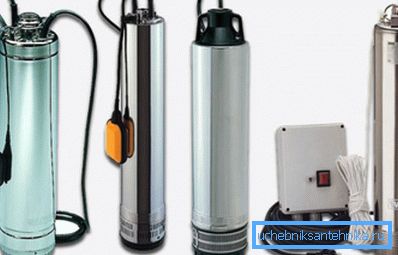
Preliminary events
Before you choose a pump for a well or a well, you need to consider some features of your system:
- Type of water intake - that will be used as a water source - a simple well, a well-well or one of the types of wells - sand or artesian. This factor is taken into account in the first place.

- The diameter of the well or well is also important, because too narrow a pipe will accommodate not every pump.. And knowing the diameter and depth, you can accurately calculate the supply of water at the source.
- Static water level in the well - this indicator is quite simple to calculate, you need to let the water stand for a day and measure the distance from the water surface to the bottom.
- The dynamic level is somewhat more difficult to calculate, but it can also be done by hand without the involvement of specialists.. If you have all the necessary documents with the data when the well is set up, then you will have to do the calculations yourself in the well - you need to pump a certain amount of water from the source, for example 100 liters, and measure how much the level has dropped. The lower this value, the better.
- The distance from the water intake to the house. The fact is that besides pumping water, the pump must maintain a certain pressure in the system. The longer the pipe, the higher the pressure loss.
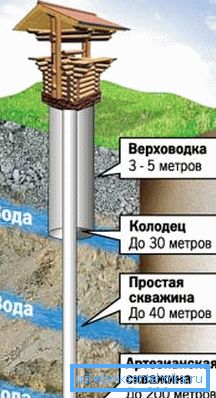
Note! If you have a supply of water or, as it is also called, the well’s debit is small, you should not choose too powerful equipment to avoid a “dry run”, as this will lead to a breakdown.
Types of equipment
The network has a sufficient amount of information on how to select borehole pumps for a particular type of water intake, but most often such reviews focus on a particular equipment. There are too few comparative reviews, therefore we will consider the features of each type in the light of its comparison with its analogues.
Surface aggregates
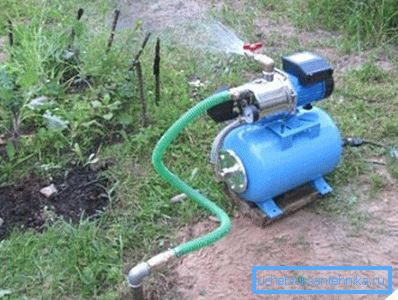
This group includes all equipment that is located on the surface of the earth in the course of work and pumps water through a lowered hose.
The main features include the following:
- The optimum height of the water rise - no more than 8 meters. This is due to the fact that a dilution effect is applied to the movement of a fluid, and it can be created at a great depth only if the equipment has enormous power, which is absolutely unjustified.
- For depths that are more than a threshold value by several meters, you can add a special device to the system - an ejector, which will create additional pressure and facilitate the operation of the pump. But even with this device to pump water from a depth of over 15 meters is not recommended due to increased wear of equipment.
- Water can be taken at a distance of at least 10 cm from the bottom of the well, while the submersible pump requires at least 1 meter of space. This is very important with a shallow depth of the source, in these cases this option has no alternatives.
- It is impossible not to touch on the moment of the features of the devices in question how to choose pumps for wells of the land type. There are self-priming models (their movement is achieved by air dilution), and if the system is filled with water, the device belongs to the group of units of normal suction. Differences for the user are not fundamental, but if the depth of the well is more than 8 meters, then it is better to choose a model with normal suction.
Vibrating submersible units
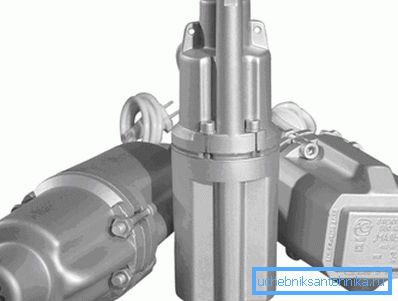
Consideration of the question of how to choose a submersible pump for a well should be started with the simplest models of vibration type.
This type of equipment has its own characteristics:
- As noted above, this group of units is the most budgetary option, it is an affordable option that can be used both main and auxiliary.
- The main limitation of use is low power, amounting to about 0.5 cubic meters per hour. This is a great option for a country plot with one crane, because already 2 cranes are not capable of vibrating units.
- In the process, the equipment vibrates very much. And if it is unprincipled for a well, then a mesh filter is most often damaged in the well and becomes unusable.
- The advantages include ease of operation, high performance (height of water rise can be up to 40 meters), as well as mobility, which is very important for seasonal use. Due to their compact size, carrying and transporting is very convenient.
- High maintainability - you can easily replace the main working parts with your own hands. They are commercially available, and replacement instructions are included in the kit.
Centrifugal submersible units

It is impossible to fully consider how to choose submersible pumps for wells or wells, without affecting the largest and most popular among developers group of equipment - submersible pumps, which use a system of one or more paddle discs to supply water.
Consider the main features of this type of device:
- The pumps are completely in the water, and the maximum immersion depth should not be more than 7 meters to prevent overloads.
- During operation, the equipment creates powerful traction, so that a so-called “suction cone” is formed under the pump, so the equipment cannot be located closer than 1 meter from the bottom to avoid raising and sucking large amounts of sand.
- Manufacturers recommend using the equipment only in conjunction with protective filters and a set of automation.
- The power of the equipment should be sufficient to meet your needs, but it should not exceed the debit of the well or well - this is fraught with "dry work" and breakdown of the pump.
Note! According to statistics, when using models with lower water intake, wells are silted much less frequently than with the upper one. This factor should also be considered.
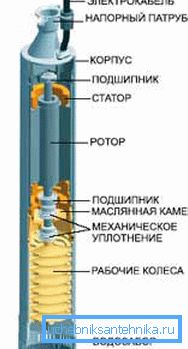
Due to the design features, this is the most powerful type of units, which is able to lift water from transcendent depths exceeding 100 meters, but the following chapter will answer how to choose the well pump.
The main criteria for selection
After determining the type of equipment, you should choose the best option, taking into account the following factors:
- The diameter of the pump, if you have a question, how to choose a well pump for a well, this item can be omitted, but it is relevant for the well, since the diameters of the sources differ within large limits.
- The quality of water, each unit has a maximum permissible level of impurities, above which significantly reduces the service life of some nodes.
- Power - this figure depends on the required amount of water, and on the debit of the well, otherwise the equipment can burn, working dry.
- The required pressure in the system and the length of the pipe from the water intake to the house is an important indicator, because the greater the distance, the greater the pressure loss in the system.
- Equipment manufacturer - do not save money to the detriment of technical characteristics.
- To prevent damage to the pump from water hammer, use a pressure sensor and pressure tank in the system.

Conclusion
In this review, we looked at how to choose the right pump for a well or a well. Given all the requirements, you can easily find the best option.